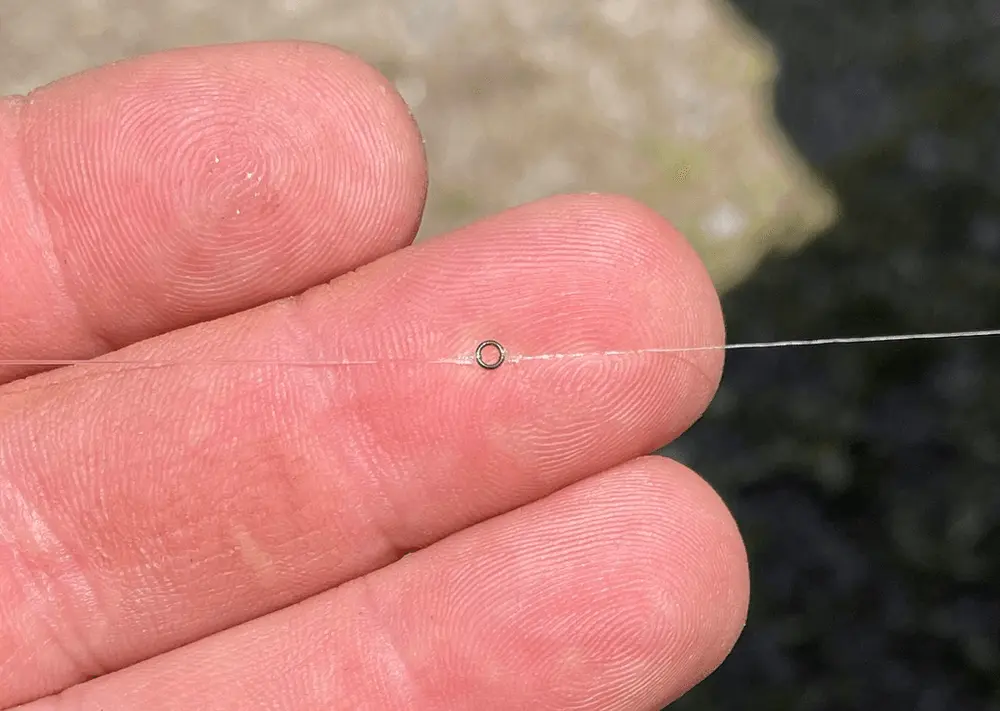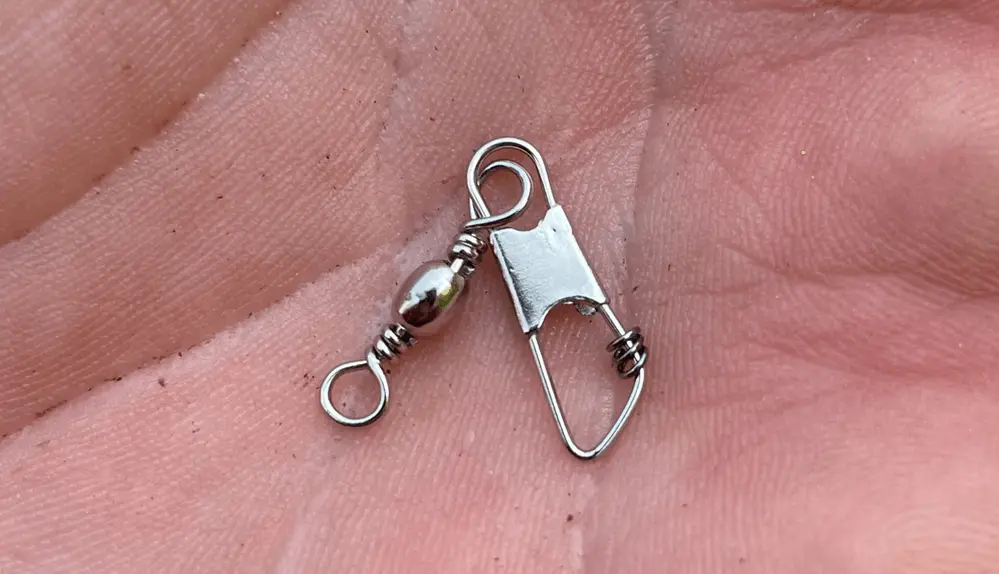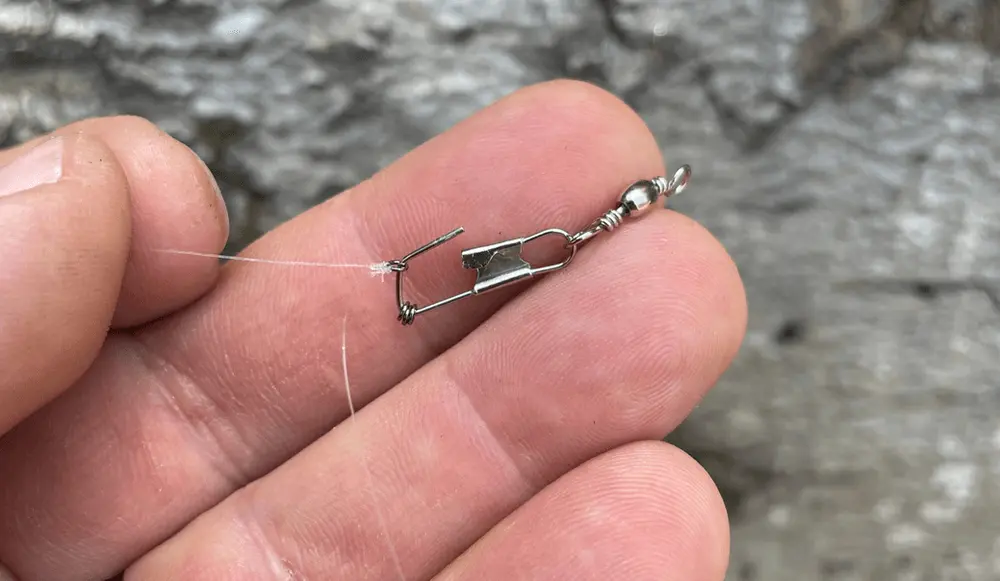Tippet Rings: How and When to Use Them

Tippet rings have become a necessary part of my fly fishing set up. They increase the life of your leader and make changing tippet sizes a breeze. Simply attach one to the end of your leader with a clinch knot, and then use another clinch knot to attach the tippet to the ring. Easy as can be.
Tippet rings come in a variety of sizes. 2mm is the most common trout size and has a breaking strength of 25 pounds. 3mm is used for steelhead and even salmon and has a breaking strength of 45 pounds. You can also get 4.5mm tippet rings for “big game” such as musky.
For fishing lighter setups, you can purchase tippet rings in 1mm, which are great for fishing smaller dry flies. When using a tippet ring for fishing dry flies, though, I lengthen the tippet substantially to reduce the effect of any increased drag the ring might incur. However, I believe this drag to be minimal and on par with the drag incurred by any knotted junction anyway.
Drawback of Tippet Rings
The main drawback to using tippet rings is that they are small and can be hard to handle. The best way I’ve found to offset this is to feed them into a swivel snap. Tie the leader or tippet to the ring while it’s still on the snap. When done, open the snap and slide off the ring. And oh yeah, always make sure to tie the line to the ring on the end closest to the snap opening. Yes, I’ve made this stupid mistake, usually when I’m in a hurry or in low light!
Fortunately, most companies have caught onto this trick and sell the rings already on a snap. If for some reason you’re buying rings that come loose in a package, I cannot emphasize enough the value of placing them onto a snap.

Another potential drawback is that they can be so reliable that you take them for granted and forget to change them after prolonged use. Or at least check them for wear. They can bang off of rocks and structure just like everything else and become worn. Every now and then it doesn’t hurt to retie them, especially if using lighter diameter leaders and tippets.
Some Euronymphers frown on using tippet rings because they have the potential to interrupt strike sensitivity, maybe even cause a slight delay in how the strike is identified. I’m not sold on this argument. Sure, it is a metal object located between you and the fly, but as with drag, it’s diameter is often no bigger than a typical blood knot or other type of leader and tippet connection.
Shop Now for Tippet Rings
This is an affiliate link. Commissions earned from purchases helps support the Dark Skies Fly Fishing website and magazine. Thank you!
Shop NowBenefits of Tippet Rings
Overall, I find tippet rings to provide a stronger and more reliable connection than just about any direct line to line connection. They’re also very convenient and make tippet changes quick and painless. I seldom retie a 2mm or larger tippet ring used on a 5x or heavier leader until I’m ready to change the leader itself.
In cold weather, when I can’t seem to get my fingers to do what I want them to do, it’s nice to tie on a tippet ring before heading out, while my hands are still warm. Once on the water, I then select the tippet I want to use in that particular situation and tie it to the ring directly across from the leader with a clinch knot, too.
Technically, you could attach a second tippet to the tippet ring as a tag for a two-fly rig. However, this isn’t ideal because the tag could slide to the bottom of the ring and twist around the main tippet much easier than using a triple surgeon’s knot to tie in a tag directly above your point fly in a perpendicular position. Also, I generally use 2-3 feet of tippet material, and a tag or dropper fly should be a lot closer to the point fly than that in most situations anyway.

When Should You Use a Tippet Ring?
Any time is a good time to use a tippet ring. I see no serious drawbacks to them. If you’re really concerned about any impact they might have on dry fly drifts, then perhaps using a line-to-line connection is the way to go. But speaking from experience, I have used even 2mm tippet rings when fishing size 20 Baetis Emergers over incredibly spooky fish and have still caught a lot of fish. If you’re experiencing drag or refusals of any kind, chances are it’s because of your pattern selection or tippet size, not because of the tippet ring.
Are tippet rings one more piece of “equipment” to carry? Yes. But they’re relatively inexpensive, usually a quarter to fifty cents apiece, depending on the brand. I haven’t noticed any substantial differences in quality between brands either, so if you’re paying more than that, you’re likely paying for the name, not for any extra quality.
Once I started using tippet rings, there was no turning back. Their simplicity and time saved on the water make them invaluable.
Did You Find This Guide On Tippet Rings To Be Helpful?
Stay up to date with the Dark Skies Fly Fishing monthly newsletter for free and receive the latest posts in fly fishing news, tricks, tips, and techniques, stream reports, as well as updates on new flies added to the Online Store and exclusive discounts!
Sign Up Now
Your last line sums it up “Once I started using tippet rings, there was no turning back. Their simplicity and time saved on the water make them invaluable.” I have not been fishing long but used these from the start: they are still on my leader and will be replaced if need be.
Thank you for reading, John, and for taking the time to leave a comment. Best of luck on the water.
Looking forward to trying rings whenntheice comes off. Long time fisher and always used line to line connections. The problem there is you lose some leader when it’s time to refresher or replace a tippet. Big fish on light tippet makes that necessary more often then you think. Good article by the way.
Hi Ralph.
Your tippet ring article has me interested in trying them. A question or 2 come to mind:
After tying one to a brand new leader, say 4x, do I continue with the same size tippet extension? Also, can a tippet extension be “too long”? I see you prefer about 2 feet.
PS I really enjoyed your first edition of the new digital magazine.
Hi Tim, thank you so much for reading and glad you enjoy the magazine! Lots of big things in store for issue #2 as well!
To answer your questions about the tippet rings, I generally use a tippet one size smaller than the leader. That way, if I get snagged, it’s more likely the tippet will break rather than the leader. As for length of the tippet, I’ve used them up to 3-4 feet long without issue. I use the two feet as a general guideline for tippet length, but if longer is required, then don’t be afraid to use longer. The only difference you may notice is when casting a dry fly. The leader will turn over, but a really long tippet is a little hard to get to turn over.
Thank you again for reading and taking the time to comment!
Ralph
Don’t buy the really cheap ones on Amazon, they can be sharp and cut your line as my friend unfortunately found out. The brand name ones like Rio are probably pretty comparable. My favorite is Riverge, but you may have to get them from the UK.
Terrific piece. Well done. Thank you.
I’ve used tippet rings for years but I am striking out on a new venture, the pursuit of carp here in North Texas. I’m using fluorocarbon leaders and tippets for its sinking performance. I recall reading somewhere that tippet rings float, apparently due to surface tension. Do you have any thoughts about whether rings will adversely affect the sink rate of this fluorocarbon leader set-up?
Many thanks,
Dale Smith
Fort Worth, TX
Hi Dale,
Thank you for reading and commenting on this post about tippet rings. I’m a big fan of them and use them for all occasions, whether I’m fishing dry flies or nymphs. In my experience, they do not adversely affect sink rate. And what you read is correct. They’re so light that they do not break surface tension and therefore do not impact a fluorocarbon or nylon/mono setup at all. Just my two cents!
Best of luck on those carp!
Ralph
Ralph – I used them for a while and figured they were something the Euro Nymphing guys used. I plan to go back them this spring to save my leader. for some reason I seem to have longer tag ends. I am not a tandem fly user, they always get tangled when I try. I am still searching for the best leaders for dries vs nymphs. If I had that then I would be using two flies all day long. Any help on that my conquest and is there such a thing? BLUF I will be going back to tippet rings.
Brian
PS – it took me two lost rings in a creek to figure out, to tie the leader while the ring was still on the snap swivel. Great tip for those that haven’t figured it out. Another good tip, I have my snap swivel on my glasses holder so I don’t lose that small thing either or spent a huge amount of time looking for it in my pack.